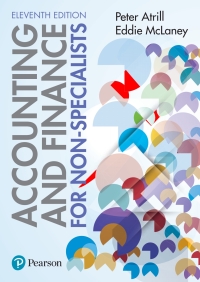Answered step by step
Verified Expert Solution
Question
1 Approved Answer
BOR CPAs, Inc. BOR CPAs, Inc. is a closely held corporation owned by three stockholders who used the initials of their last names to form
BOR CPAs, Inc.
BOR CPAs, Inc. is a closely held corporation owned by three stockholders who used the initials of their last names to form the corporations name: Cyrus Bailey, John Ogden, and Samuel Rogers. The firms Certified Public Accountants CPAs perform audits of both public companies and privately owned companies. BORs CPAs also provide tax services to both individuals and businesses.
The corporation is divided into two profit centers: the Audit Division and the Tax Division. Each division is composed of two cost centers. The Audit Division is composed of two costcenter departments: Public Company Audits and Private Company Audits. The Tax Division is composed of two costcenter departments also: Individual Tax and Business Tax.
BOR, a decentralized organization, is interested in evaluating the performance of the two divisions. The stockholders are responsible for deciding on investment in the two divisions. Cyrus Bailey is in charge of the performance evaluation, and turns to you for assistance. Mr Bailey is only interested in evaluating operations at the profit center division level, and not at the cost center department level.
Mr Bailey is considering temporarily using some of the staff from the Tax Division to assist the Audit Division during the upcoming busy audit season, and would like to evaluate the effect of this on net income. The Tax Division is estimated to have hours of excess capacity.
The unit for determining sales revenue in both divisions is the "engagement", which means the total agreedupon work for a given client in either audit or tax for a given year. The company charges on average a fee of $ per audit engagement, and $ per tax engagement.
The company has its own Payroll Office, which provides payroll services to both divisions and will allocate its total expenses to the two divisions as support department allocations.
The following chart shows some basic data for the company:
Hourly market rate for staff the price the company would have to pay from an outside
contractor for staff services $
Average hourly cost rate for staff the average price the company pays to its staff $
Number of paychecks issued by Audit Division
Number of paychecks issued by Tax Division
Total expense for Payroll Office $
Amount of assets invested in Audit Division by BOR CPAs, Inc. $
Amount of assets invested in Tax Division by BOR CPAs, Inc. $
Payroll
Mr Bailey would like you to start by analyzing the Payroll Office expenses, and allocating the total expenses to each division. He has decided to use the number of payroll checks as the activity base for the allocation.
Fill in the following blanks, allocating the total expense for the Payroll Office to each of the two divisions.
Payroll Charge Rate $fill in the blank fcdfbcfd
per payroll check
Division Support Department
Allocations
Audit Division $fill in the blank fcdfbcfd
Tax Division $fill in the blank fcdfbcfd
Question Content Area
Performance Evaluation
A profit center manager has the responsibility and authority for making decisions that affect revenues and costs and, thus, profits. The manager of a profit center does not make decisions concerning the fixed assets invested in the center. Responsibility accounting for profit centers such as the Audit Division and Tax Division take the form of income statements, which should include only controllable revenues and controllable expenses.
Although it is not technically a decentralized unit, BOR CPAs, Inc. as a whole may be considered as an investment center. Thus, Mr Bailey is also interested in evaluating the performance of the company as a whole. Two performance measures that are used at the investment center level are return on investment and residual income.
Mr Bailey would like to use the DuPont formula, composed of profit margin and investment turnover, to break down the return on investment, in order to evaluate each division. At the company level, Mr Bailey would like to use return on investment to evaluate the overall performance of the company and its investment decisions with regard to each division.
Answer the following questions and
What is the most likely reason Mr Bailey chose the DuPont formula to evaluate the divisions?
a Mr Bailey wants to focus on whether the profit centers are spending in accordance with their budgets.
b Mr Bailey believes that the investment turnover will provide a good assessment of each divisions profitability.
c Mr Bailey would like to analyze differences in the return on investment across divisions.
What is the most likely reason Mr Bailey chose return on investment to evaluate the company as a whole?
a Mr Bailey would like to determine which division has the highest net income.
b Return on investment will allow Mr Bailey to measure the income ret
Step by Step Solution
There are 3 Steps involved in it
Step: 1

Get Instant Access to Expert-Tailored Solutions
See step-by-step solutions with expert insights and AI powered tools for academic success
Step: 2

Step: 3

Ace Your Homework with AI
Get the answers you need in no time with our AI-driven, step-by-step assistance
Get Started


